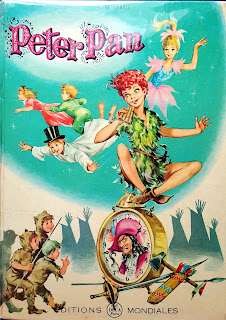The illustrations led me to think this translation must be very different from Barrie's story. Note that Tinker Bell is hardly the size of a hand, unless that hand belongs to a giant.
I don't speak French (and if someone who does wants to take a look at the book for me, I'd welcome the input), but some time with Google Translate showed me that the story wasn't changed significantly more than other versions simplified for young children. What differs is the inclusion of The Little White Bird in the narrative, including how Peter Pan came to run away from home and how he met a little girl named Mamie. Allusions to those events at the end of the picture book draw the two stories together in a way I haven't seen before: Peter speaks of his mother, who may well be dead since he hasn't seen in her in so long, and returns to Kensington Gardens to play his music for Queen Mab and her fairy subjects.
Some fun bits of the translation include Tinker Bell being renamed Campanelle (after all, a bell tower, or campanile, is a rather more flattering comparison than a bell on a tinker's cart), and the names of the lost boys. Google Translate and some other internet research tells us we have Pipeau (Pipe), Panache (Plume), Plume-au-Vent (Feather on the Wind), Frisottin (Frizzy), Casse-Cou (Daredevil), and Pavre-Fueille (Poor Leaf). Compare these with Tootles, Nibs, Slightly, Curly, and the unnamed twins of the original. Most of the pirates are not named (hmph), but Captain Hook becomes the Pirate Harpon--a title I think the Captain would appreciate. Wendy's brothers are now Mike and Johnny.
There are no pictures of the mermaids, which makes me sad, but this is a rather nice Hook, er,Harpon. The book appears to an international endeavor from Editions Mondiales, Duca del Paris, Paris/Impremerie Steb, Bologne (Italie), with "editorial realization" by Roberto Borghi, adapted by Saulla Dello Strologo, and illustrations by Giu-Pin.
Peter Pan editions published after the 1957 Disney animated film usually show its influence, and Peter's depiction here seems to follow that pattern. I'm a bit concerned about a boy this age and size staying afloat for long in the nest of a bird small enough to make its home in England's Kensington Gardens. Tiger Lily seems to come straight from the cartoon as well, but Wendy in red is an original.




